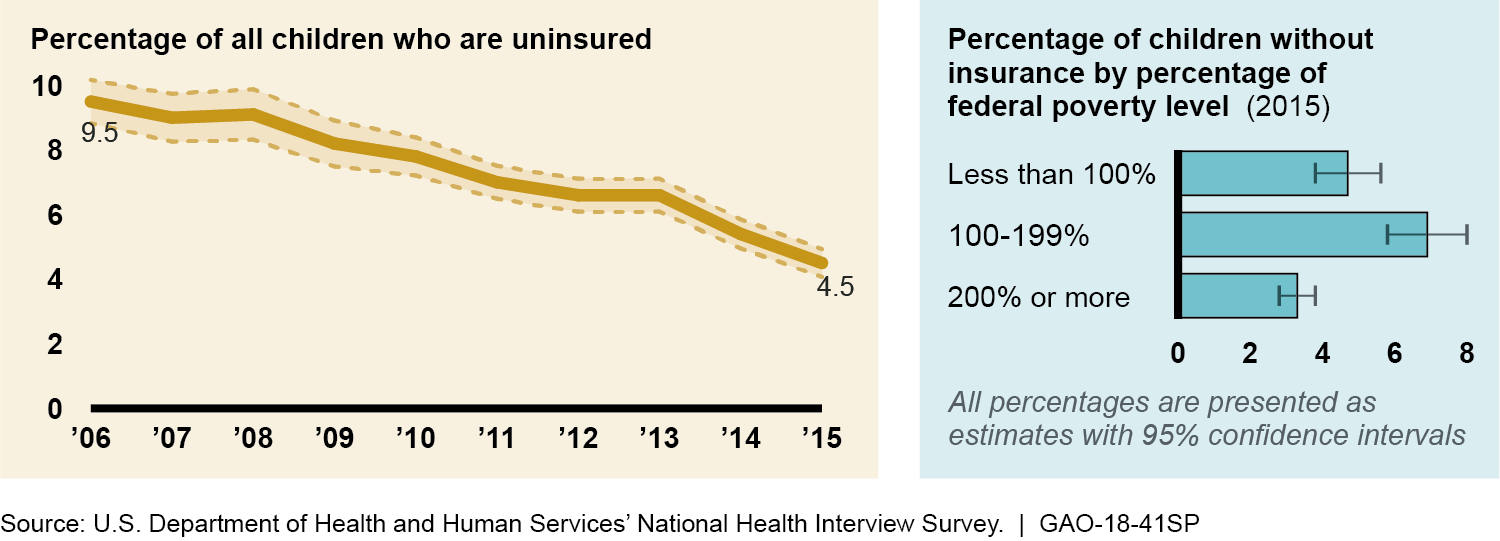Child Well-Being: Key Considerations for Policymakers, Including the Need for a Federal Cross-Agency Priority Goal
Highlights
The long-term success of a nation depends in large part on how well families and society care for their children. Child well-being can be measured through various indicators that reflect a child’s family, physical, and social environments, health, and education. This report examines what is known about the state of child well-being and discusses selected experts’ views on what policymakers could consider when addressing it. While many factors influence a child’s well-being, poverty—particularly early in life—can have long-term consequences in many areas, such as the ability to be successful in school and work. In 2016, about 18 percent of children in the United States lived in poverty, with some groups faring worse than others.
Estimated Percentage of U.S. Children Living in Poverty, by Race and Ethnicity

Note: Estimates for Black children have a margin of error no greater than plus or minus 2.3 percentage points; for Hispanic children plus or minus 1.7; and for White children and all children no greater than plus or minus 0.8 percentage points. All estimates are at the 95 percent level of confidence. The federal poverty thresholds are updated by the U.S. Census Bureau each year; in 2016, the poverty threshold for a family of four with two children was $24,339.
Section 1: Federal Data Show That Child Well-Being Has Improved in Some Areas but Not in Others, and Children with Certain Characteristics Have Fared Worse than Others
In recent years, the well-being of children in the United States has improved in some areas but not in others, and well-being continues to be generally worse for children who are minority, poor, and/or from families headed by single mothers (compared to married parents), according to the federal data GAO reviewed. Federal data show higher high school graduation rates and a greater percentage of children who have health insurance, although this varied based on children’s characteristics.

Note: “Federal poverty level” refers to the U.S. Census Bureau’s poverty thresholds for the previous calendar year.
Areas where children have fared worse over the last decade include depression and student homelessness. In school year 2014-15, about 1.26 million students were identified as homeless by public school districts, compared to less than one million in school year 2005-06.

Note: Data are based on the U.S. Department of Agriculture’s measure of food security calculated from responses to a series of questions about the conditions and behaviors that characterize households when they are having difficulty meeting basic food needs
Section 2: Experts Noted Several Considerations for Policymakers Seeking to Address the Multiple Dimensions of Child Well-Being
Experts interviewed by GAO expressed a range of viewpoints on how policymakers could address child well-being, such as considering the whole family when addressing the needs of children and coordinating efforts among federal, state, local, and non-governmental entities, among other areas. Experts suggested that policymakers consider ways to support a family’s ability to provide the safe, supportive, and nurturing environment that children need. For example, some experts highlighted the role of policies that promote marriage or encourage the maintenance of two-income households.
With respect to coordination, experts discussed the importance of federal agencies coordinating with stakeholders inside and outside government to address child well-being. At the federal level, several experts suggested that efforts to address child well-being are hindered by insufficient coordination, noting that federal agencies generally lack the multidisciplinary structure needed for a coordinated approach. The Office of Management and Budget (OMB) is required to coordinate with agencies to develop federal government priority goals (known as cross-agency priority or CAP goals). These are longterm, outcome-oriented goals that cover a limited number of crosscutting policy areas. To date, child well-being has not been designated as a CAP goal. OMB is reviewing the current administration’s priorities to help develop new goals. By highlighting child well-being as an overarching priority area and ensuring that this priority is reflected in agencies’ strategic plans, OMB could help draw needed attention to federal efforts to improve child well-being.
Recommendation for Executive Action
GAO recommends that OMB consider developing a goal that addresses a coordinated federal approach to child well-being among its next set of cross-agency priority, or CAP, goals, including working with relevant agencies to ensure their strategic plans include related goals and objectives. OMB neither agreed nor disagreed with the recommendation and noted that it is currently in the process of developing the next set of CAP goals.
For more information, contact Kathryn A. Larin at (202) 512-7215 or larink@gao.gov.
Recommendations
Recommendations for Executive Action
| Agency Affected | Recommendation | Status |
|---|---|---|
| Office of Management and Budget | GAO recommends that the Director of OMB consider developing a goal that addresses a coordinated federal approach to child well-being among its next set of cross-agency priority (CAP) goals, including working with relevant agencies to ensure their strategic plans include goals and objectives related to the CAP goal. (Recommendation 1) |
OMB neither agreed nor disagreed with this recommendation. In November 2017, OMB staff noted that the agency was developing its next set of CAP goals, which are usually reserved for a limited set of priorities, and expects to announce these goals concurrent with the FY19 budget. As part of the process, agency staff said they consult relevant Congressional committees and other stakeholders. As of December 2022, OMB reported that it does not plan to take further action on this recommendation. We continue to believe this recommendation could provide an opportunity across the federal government to better address the needs of children in ways that take into account the interrelatedness of federal actions and policies that aim to improve child well-being. To implement this recommendation, OMB should provide documentation that it considered developing a CAP goal that addresses a coordinated federal approach to child well-being. As of March 2025, OMB has not provided any further updates on this recommendation.
|
